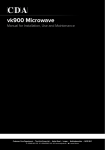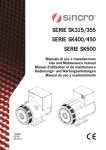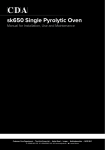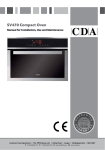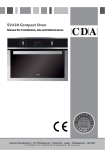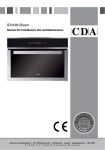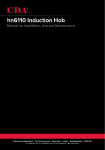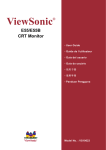Download CDA sk450 Specifications
Transcript
sk450 Single Ecoclean Oven Manual for Installation, Use and Maintenance Customer Care Department • The Group Ltd. • Harby Road • Langar • Nottinghamshire • NG13 9HY T : 01949 862 012 F : 01949 862 003 E : [email protected] W : www.cda.eu Important This appliance must only be used for the purpose for which it is intended, i.e. domestic cooking, defrosting and reheating foods. Any other use could be dangerous and may lead to premature failure of the appliance. The CDA Group Ltd cannot be held responsible for injuries or losses caused by incorrect use or installation of this product. Please note that CDA reserve the right to invalidate the guarantee supplied with this product following incorrect installation or misuse of the appliance. User information: • Ovens become hot during and immediately after use. Ensure you do not touch the heating elements located inside the appliance. • The oven door can become very hot during operation. • After use, please ensure that the appliance is switched off. • Keep children away from the appliance when in use, and immediately after use. • Keep the oven door closed when in use. Appliance information: Please enter the details on the appliance rating plate below for reference, to assist CDA Customer Care in the event of a fault with your appliance and to register your appliance for guarantee purposes. Appliance Model Serial Number 2 CE Declarations of Conformity: This oven has been designed, constructed and marketed in compliance with safety requirements of EEC Directive 2006/95/EEC (Low voltage) and requirements of EMC Directive 2004/108/EEC. This appliance has been manufactured to the strictest standards and complies with all applicable legislation, including Electrical safety (LVD) and Electromagnetic interference compatibility (EMC). Parts intended to come into contact with food conform to EEC/89/109.4 IMPORTANT INFORMATION FOR CORRECT DISPOSAL OF THE PRODUCT IN ACCORDANCE WITH EC DIRECTIVE 2002/96/EC. At the end of its working life, the product must be taken to a special local authority waste collection centre or to a dealer providing appliance recycling services. Disposing of a household appliance separately avoids possible negative consequences for the environment and health. It also enables the constituent materials to be recovered, saving both energy and resources. As a reminder of the need to dispose of household appliances separately, the product is marked with a crossed-out wheeled dustbin. 3 Important • Read the user instructions carefully before using the oven for the first time. • Follow the instructions for first use of the oven. • Clean the oven regularly. • Remove spills as soon as they occur. • Always use oven gloves when removing shelves and trays from the ovens. • Do not allow children near the oven when in use. • Do not allow fat or oils to build up on the oven shelves, grill pan or oven base. • Do not place any cooking utensils or plates directly on the oven base. • Always grill with the oven door closed. • Do not grill food containing fat without using the grill pan grid. • Do not cover the grill pan grid or the oven walls with aluminium foil. • Do not use the oven tray for roasting. • Do not perform maintenance or cleaning of the oven without first switching off the electricity supply. If the oven has recently been used, allow to cool. • Do not place hot enamel parts in water. Leave them to cool first. • Do not allow vinegar, coffee, milk, saltwater, lemon or tomato juice to remain in contact with enamel parts. • Do not use abrasive cleaners or powders that will scratch the surface of the enamel. • Do not attempt to repair the internal workings of your oven. 4 Using the Touch Controls The touch controls should be used with the flat of your finger, rather than the fingertip. fig. 1 5 The Control Panel A B C D J K E F G L M fig. 2 I A: Oven light B: Conventional oven C: Warming oven D: Half grill E: Full grill F: Fanned grill G: Fan assisted oven H: Fan oven I: On/Off and key lock J: Rapid preheat K: Oven clean L: Stop M:Start 6 H N O U V P W Q X R S Y Z T N: Fan oven + lower heat O:Defrost P: Auto recipe Q:Confirm R: Scroll downward / Reduce power S: Scroll upward / Increase power T: Digital display U: Timer function V: Timer - cooking time W: Timer - end time X: Minute minder Y: Decrease settings Z: Increase settings 7 Before First Use When the oven is connected to the electrical supply for the first time, the display will ask you to select your language: Use the buttons to select the language you want, use the “ok” button to confirm your choice. The oven will remember your language preference, even after future power outages. After setting the language, the oven will go into “demonstration” mode (it will also go into this mode after any power failure). In this mode, the oven keys light up in sequence but no heating elements are powered. The control panel is inactive so the oven will not respond to commands. To exit the demonstration mode, touch the “Light” key for approximately five seconds, the control panel will revert to normal operation and be ready for use. You can set the clock at this stage, but it is not necessary for turning on the oven. Before using the oven for the first time we recommend that you clean it with soapy water, rinse carefully and then heat on the fan oven setting at maximum temperature for 30 minutes. A slightly unpleasant smell may be produced, caused by grease remaining on the oven elements from the production process. 8 General Settings & Use Clock To set the clock, touch the “Timer function” key for at least 3 seconds, the clock will show “00:00” with the separator dots flashing. Use the “+” and “-” keys to set the correct time: Five seconds after selecting the time the dots will stop flashing and the time will be set. Key lock This appliance is equipped with a key lock to prevent accidental use. For safety reasons the “On/Off” key will work to switch the appliance off when the key lock is set. To switch the key lock on or off, touch and hold the “On/Off” key the appliance will give a brief beep when the button is first pressed and a longer beep after three seconds, when the key lock is either activated or deactivated. The padlock closed symbol will show in the display when the key lock is on and the padlock open symbol when the key lock is off. Oven light The oven light may be turned on and off by touching the “Oven light” key . Alternatively, the oven light will turn on automatically when the door is opened then after the door is closed will stay on for approximately three minutes before automatically turning itself off. 9 To turn the oven on Touch the “On/Off” key briefly, it gives one short beep followed immediately by a long one, the word ”ON” appears on the display for approximately one minute. To turn the oven off Touch the “On/Off” key briefly, it gives one long beep, the word ”OFF” appears briefly on the display. While the word “ON” is showing on the display, any of the cooking functions can be selected by touching one of the function keys. If a cooking function is not selected within one minute the oven will switch itself off and the word “OFF” will show briefly on the display. The cooking functions available when the oven is on are: Conventional oven First touch the “On/Off” key (as above), then touch the “Conventional oven” key. The cooking temperature defaults to 190°C and can be set between 50-250 (MAX) °C in 5˚C increments. The temperature can be changed at any time by touching the keys. During heating the “°C” symbol flashes and the display shows the actual temperature in the oven. 10 Warming oven First touch the “On/Off” key (as p10), then touch the “Warming oven” key. The warming oven programme allows you to prove dough and bake blind, using just heat from below. The cooking temperature defaults to 50°C and can be set between 50-250 (MAX) °C in 5˚C increments. The temperature can be changed at any time by touching the keys. During heating the “°C” symbol flashes and the display shows the actual temperature in the oven. Full Grill and Half grill First touch the “On/Off” key (as p10), then touch the “Full grill” or “Half grill” key. The grill programmes use just the grill elements to provide top heat for grilling or browning foods. The rack should be placed in as high a position as possible to bring the food close to the element. The food needs to be turned over during cooking to ensure both sides are cooked. The grill should be preheated for approximately two minutes before starting to cook. The cooking temperature defaults to MAX and can be set between 50-250 (MAX) °C in 5˚C increments. The temperature can be changed at any time by touching the keys. During heating the “°C” symbol flashes and the display shows the actual temperature in the oven. 11 Fanned grill First touch the “On/Off” key (as p10), then touch the “Fanned grill” key. The fanned grill programme uses the grill element for grilling and the fan to help circulate heat around the food. This is ideal for cooking on several shelves. The cooking temperature defaults to 165°C and can be set between 50-250 (MAX) °C in 5˚C increments. The temperature can be changed at any time by touching the keys. During heating the “°C” symbol flashes and the display shows the actual temperature in the oven. Fan assisted oven First touch the “On/Off” key (as p10), then touch the “Fan assisted oven” key. The fan assisted oven programme uses the fan to circulate heat produced by the top and bottom elements to give an even temperature throughout the oven. The cooking temperature defaults to 165°C and can be set between 50-250 (MAX) °C in 5˚C increments. The temperature can be changed at any time by touching the keys. During heating the “°C” symbol flashes and the display shows the actual temperature in the oven. Fan oven First touch the “On/Off” key (as p10), then touch the “Fan oven” key. The fan oven programme allows you to cook and brown foods just as you would in a traditional oven. The cooking temperature defaults to 165°C and can be set between 50-250 (MAX) °C in 5˚C increments. 12 The temperature can be changed at any time by touching the keys. During heating the “°C” symbol flashes and the display shows the actual temperature in the oven. Fan oven + lower heat First touch the “On/Off” key (as p10), then touch the “Fan oven + lower heat” key. The fan oven + lower heat programme uses the fan element to enhance the heat from the bottom element to create an ideal environment for cooking pizzas. The cooking temperature defaults to 230°C and can be set between 50-250 (MAX) °C in 5˚C increments. The temperature can be changed at any time by touching the keys. During heating the “°C” symbol flashes and the display shows the actual temperature in the oven. Defrost First touch the “On/Off” key (as p10), then touch the “Defrost” key. The defrost programme uses the the fan to circulate air for defrosting with the option of gentle heat to accelerate the process. This is not a cooking programme. The defrost temperature defaults to unheated or can be set between 40-60°C in 5˚C increments. The temperature can be changed at any time by touching the keys. During heating the “°C” symbol flashes and the display shows the actual temperature in the oven. 13 Use of the Food Probe The food probe is a thermometer which, when inserted into your food in the oven, makes it possible to check its internal temperature and use it to establish when it is cooked through. Using the food probe 1. The probe must be plugged into the oven before the oven is switched on. 2. Locate the food probe socket, situated in the top front corner of the oven cavity, protected by a metal cover. 3. Lift the metal cover. 4. Push the plug in as far as it will go. If it is correctly inserted, the oven will beep. 5. Push the probe into the centre of the food, avoiding touching bones or fatty areas. 6. Select the cooking programme you require as described above, and set the cooking temperature. 7. After 5 seconds the temperature display will switch to the probe setting. Use the keys to adjust this as required. 8. After a further 5 seconds the oven will start. 9. When the probe detects that the food temperature has reached its set temperature the oven will switch off, beep and display the message “PROGRAM FINISHED REMOVE THE DISH”. 14 fig. 3 If at any time you want to change either the probe set temperature or the oven setting temperature, touch the “ok” key to toggle the display between the setting temperatures. Then use the keys to adjust the setting. Note: When using the food probe the preset temperatures for all programmes are changed. The cooking temperature with probe defaults to 165°C and can be set between 120-250°C. Note: The defrosting programme is deactivated when the probe is plugged in. Note: The probe will not work if it is connected when the oven is already switched on. Special Functions Rapid preheat This function shortens overall cooking times by preheating the oven faster than it would normally. This is activated by touching the “Rapid preheat” key AFTER a cooking function is selected, the oven beeps once and the “Rapid preheat” key lights up red to show this is activated. This function may be deactivated at any time by touching the “Rapid 15 preheat” key again, the oven beeps twice and the “Rapid preheat” key returns to white lighting to show this is deactivated. Oven clean This function cleans the oven’s catalytic side and rear panels by running a maximum temperature cycle. The “Oven clean” function can only be used when no cooking function has been selected. First touch the “On/Off” key (as p10), then touch the “Oven clean” key for five seconds. The oven light is switched on and can be switched off and on again at any time. All the self-cleaning panels will perform effectively for thirty cleaning processes, after this limit the panels should be replaced if the self cleaning proerties are to be retained (See page 21). Automatic Recipes Automatic recipes First touch the “On/Off” key (as p10), then touch the “Automatic recipes” key. The display shows 2 options, “Personal recipes” (see below) or “Preset recipes” Use the keys to select the option required then confirm by touching the “ok” key. The menu system of the microwave leads you through a series of questions to select the features of your food. Use the keys to 16 select the option required then confirm by touching the “ok” key for each selections. At the end of the process the oven displays the set cooking time; this may be adjusted up or dow using the “+” and “-” keys, then the “ok” to to start the programme running. confirm. Press the “Start” key For some programmes the oven determines that a period of preheating is required. in this case the message “PREHEAT” will show on the display; this is replaced with the message “PREHEATING FINISHED PUT IN THE DISH” when the required temperature has been reached. Insert the dish at this stage. At the end of cooking, the display will read “PROGRAM FINISHED REMOVE THE DISH” and the oven will beep until you press any key. Note: at any stage of the setting process if you make a mistake choosing the values and/or you want to change the settings of your recipe, touch the “Stop” key to cancel it and allow you to start again from the beginning of the procedure. If a change to the settings for a programme has been made the oven gives you the opportunity to save this as a “Personal recipe” at the end of the cooking time. Personal recipes can then be selected for future use next time. 17 Timer and Minute Minder Programming the oven This is only applicable to these functions: Fan oven Fan oven + grill Fan grill Grill Any timer functions required should be set after the relevant cooking programme has been set, and before the “start” key is touched. Timer - Cooking time Touch the “Timer function” key once so the “Cooking time” key lights up. Touch the “Cooking time” key to select it then use the “+” and “-” keys to set the cooking time; once the separator dots stop flashing the cooking time is set. Timer - End time twice so the “End time” key Touch the “Timer function” key lights up. Touch the “End time” key to select it then use the “+” and “-” keys to set the end time; once the separator dots stop flashing the end time is set. 18 Programming delayed cooking This is achieved by programming an end time (when you want the food ready) and also programming a cooking time (as the recipe). Minute minder The minute minder is a timer that is independent of the function of the oven; it times and sounds a beep but does not affect any oven functions. This is useful for timing actions that are unrelated to this appliance, for example timing eggs on the hob. Minute minder while the oven is OFF While the oven is off the minute miinder can be set by touching the “Timer function” key once then touching the “+” and “-” keys to set the time. At the end of the set time the beeper will sound. This can be stopped by touching the “Timer function” key. To cancel the timer at any stage, touch the “Timer function” key then use the “-” key to reduce the time to zero. Minute minder while the oven is ON While the oven is on the minute miinder can be set by touching the “Timer function” key three times so the “Minute minder” key lights up. Then touch the “+” and “-” keys to set the time. At the end of the set time the beeper will sound. This can be stopped by touching the “Timer function” key. To cancel the timer at any stage, touch the “Timer function” key three times, then use the “-” key to reduce the time to zero. 19 Care and Maintenance IMPORTANT: Always disconnect the appliance from the power supply before undertaking any cleaning or maintenance. You should always allow the oven to cool fully after use before undertaking any cleaning or maintenance. Changing the oven lamp • Remove all shelves and the grill pan from the oven. • Gently unclip the side rack from its lower locating stud and unhook its top to remove it. Note: No tools are required and the stud should not be removed. • Lift the catalytic liner from the oven side, noting how it hooks into position. • Carefully detach the glass cover from the lamp holder, by sliding it upward then easing the bottom outward. • Carefully remove the old bulb and insert a new bulb, suitable for high temperatures (300ºC) having the following specifications: 230-240V, 50Hz, 25W, G9 fitting. • Insert the new bulb taking care not to touch the glass with your hands as contamination from your fingers can 20 fig. 4 fig. 5 cause premature failure. Always use a clean cloth or gloves. • Reattach the glass cover, pressing it firmly into position. • Hook the catalytic panel back into position. • Replace the side rack by locating the two hooks at the top and clipping it back into position on its lower fixing stud. • Replace the oven shelves and grill pan as necessary. Please note: Bulb replacement is not covered by your guarantee. Replacing the catalytic liners Liners on the side walls • Remove all shelves and the grill pan from the oven. • Gently unclip the side rack from its lower locating stud and unhook its top to remove it. Note: No tools are required and the stud should not be removed. • Lift the catalytic liner from the oven side, noting how it hooks into position. • Replacement is a reversal of the removal process. Liner on the back wall • Remove all shelves and the grill pan from the oven. • Remove the two screws securing the bottom of the back liner to the oven by turning them anticlockwise. • Lift the catalytic liner from the oven back, noting how it hooks into position. • Replacement is a reversal of the removal process. 21 Cleaning You should only use non-abrasive cleaners. Any abrasive cleaners (including Cif) will scratch the surface and could erase the control panel markings. You should not use cleaning products with a chlorine or acidic base. Any spillages should be cleaned off immediately, especially any alkaline or acidic substances (lemon juice, vinegar etc.) Stainless steel Stainless steel can be effectively cleaned by simply using a dilute solution of water and mild detergent and drying to a shine with a clean cloth. Proprietary stainless steel cleaners are available. We recommend the CDA E-Cloth available from the CDA Sales Team for cleaning stainless steel surfaces. Enamelled parts All enamelled parts must be cleaned with a sponge and soapy water only, or other non-abrasive products. Suitable proprietary chemical cleaners may be used after first consulting with the manufacturer’s recommendations and testing a small sample on the oven cavity. Inside the oven It is recommended that the interior of the oven be cleaned after every use using suitable products, especially if any spillage has occurred. The shelves can be removed and washed by hand or in the dishwasher. 22 Catalytic liners The catalytic oven liners must only be cleaned with fresh water. For stubborn stains, boil a cup of water in the oven for 2 to 3 minutes. Steam will soften the marks prior to cleaning. Grill When used regularly, the grill element does not need cleaning as the intense heat will burn off any splashes. The interior ceiling may need regular cleaning, which should be done with warm water, detergent and a sponge. If the grill is not used regularly, it should be run for 10 minutes every month to burn off any splashes, in order to reduce the risk of fire. PLEASE NOTE: Steam cleaners must not be used to clean this appliance. Do not store flammable material in the oven. Do not allow grease or food particles to build up around the door. IMPORTANT: When correctly installed, your product meets all safety requirements laid down for this type of product. However, special care should be taken around the rear or the underneath of the appliance as these areas are not designed or intended to be touched and may contain sharp or rough edges that could cause injury. 23 Installation The appliance can be installed under a worktop or in a wall unit (open or closed) with the appropriate dimensions for recessed installation. Centre the oven in the unit so as to ensure a minimum distance of 10mm between the appliance and the surrounding unit. The material of the unit supporting the appliance must be heat resistant (or covered with a heat resistant material). For greater stability, attach the oven to the unit with two screws through the holes provided on the side panels. If the appliance is to be installed under a worktop, ensure the top rail has been removed to provide free airflow around the product. Do not use your appliance immediately after moving it from a cold location, as condensation may cause a malfunction. Wait approximately 1-2 hours before use. 24 540 560 595 594 50 510 594 597 535 21 Fig. 6 540 560 595 594 50 510 594 597 535 21 Fig. 7 25 Mains Electricity Connection Warning! This appliance must be earthed Fig. 8 We recommend that the appliance is connected by a qualified electrician, who is a member of the N.I.C.E.I.C. and who will comply with the I.E.T. and local regulations. This appliance is intended to be connected to fixed wiring and is not suitable for connection to a 13A plug or 13A supply. This appliance is intended to be connected to fixed wiring by a double pole switch, having a contact separation of at least 3mm in all poles. The switch must be positioned no further than 2m from the appliance. 26 This appliance is supplied with a 3 core mains cable; the wires are in accordance with the following code: Green and Yellow = Earth Blue = Neutral Brown = Live Please note: • The mains cable must only be replaced by a qualified electrician or service engineer and must be of equivalent or better rating (i.e. 1.5mm2, HO5V2V2-F). • The current rating of the fuse or circuit breaker protecting this appliance should be marked on the socket outlet (16A). • Assembly and electrical connection should be carried out by specialised personnel. • When installing this product we recommend you seek the help of another individual. The mains isolation switch must be accessible after installation. Appliance rated electrical power: 3500W 27 Please contact our Customer Care Department for Service on the details below. Customer Care Department • The Group Ltd. • Harby Road • Langar • Nottinghamshire • NG13 9HY T : 01949 862 012 F : 01949 862 003 E : [email protected] W : www.cda.eu




























